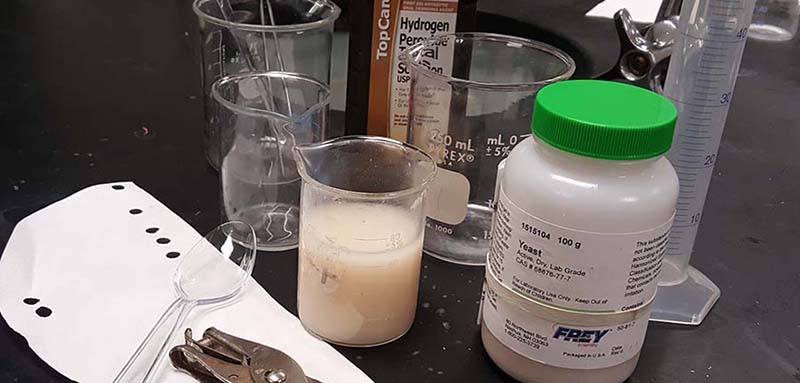Investigation: How Does Concentration Affect the Reaction Rates of Enzymes

Purpose:
- to observe the catalytic action of yeast catalase on hydrogen peroxide
- to determine the effect of concentration on yeast catalase activity
- to determine the effect of temperature on yeast catalase activity
Background information:
Hydrogen peroxide (H2O2) is a common but poisonous by-product of cellular metabolism, but H2O2 does not accumulate in cells because it is decomposed to water and oxygen gas. The decomposition of the hydrogen peroxide is facilitated by catalase, an enzyme present in most cells.
The reaction is: 2H2O2 → 2H2O + O2
One molecule of catalase can catalyze the decomposition of approximately 4 x 107 molecules H2O2 per second!
In this lab activity, you will be using yeast catalase to observe how increasing and decreasing the concentration of the enzyme and substrate can affect the reaction rate.
Materials
Hydrogen Peroxide (3%) | Multiple beakers or cups (100-300 ml) or test tubes
Graduated cylinders or other measuring tools
Filter paper and Hole punch | Forceps | Water | Stopwatch or timer
| Active dry yeast
Create your stock catalase solution
1. Dissolve 1 tsp (2-4 grams) of yeast in 200 ml of warm water.
2. Mix
well and let sit for about 3 minutes
3. Test the activity of your yeast by adding a few drops to 5 ml of
H2O2 - observe bubbles.
Observation of Catalase Activity
1. Pour 80 ml of H2O2 into a small beaker or test tube.
2. Cut a filter paper disk using a hole punch and soak this in your stock catalase, blot on a paper towel.
3. Drop the disk into the H2O2.
Describe your observations.
If nothing happens (disk just floats) you may need to troubleshoot your experiment. Try stirring your catalase solution or dipping the disk in the H2O2 to break the surface tension. If you are still not seeing anything happen, consult your instructor.
4. Perform this procedure again and record the time it takes for the disk to drop and then raise to the surface. Perform multiple trials to perfect your technique. Convert all readings to seconds to take an average.
| Trial 1 | Trial 2 | Trial 3 | Average | |
| Time |
Effect of Substrate Concentration
Your H2O2 started at 3%. You will now dilute the peroxide in order to change its concentration.
1. Place 40 ml of H2O2 into a new beaker. Add 40 ml of water. H2O2 concentration = 1.5%
2. Place 20 ml of H2O2 into a new beaker. Add 60 ml of water. H2O2 concentration = .75%
3.
Place 10 ml of H2O2 into a new beaker. Add 70 ml of water. H2O2 concentration = .375%
4. Perform the floating disk procedure for each concentration. You can copy your data for the 0.3% from the table above.
| 0.3% H2O2 | 1.5% H2O2 | 0.75% H2O2 | 0.375% H2O2 | |
| Trial 1 | ||||
| Trial 2 | ||||
| Trial 3 | ||||
| Average |
5. Create a graph that compares the averages for each concentration. Be sure to label the X and Y axis.
6. Use your graph and data to make a CLAIM that answers the question: How does decreasing the concentration of the substrate affect the enzyme reaction rate. This should be written in a complete sentence.
Effect of Enzyme Concentration
Your stock solution of catalase is your 100% solution. Create diluted solutions according to the ratios below and place each in small cups. These cups will be used to dip your filter paper disks.
1. 100% = 20 ml of catalase + 0 ml of water
2. 80 % =
16 ml of catalase + 4 ml of water
3. 60% = 12 ml of catalase + 8 ml of water
4. 40% = 8 ml of catalase
+ 12 ml of water
5. 20% = 4 ml of catalase + 16 ml of water.
6. Perform the floating disk procedure for each concentration. (We will not be taking averages this time.)
| 100% catalase | 80% catalase | 60% catalase | 40% catalase | 20% catalase | |
| Time |
7. Use your graph and data to make a CLAIM that answers the question: How does decreasing the concentration of the enzyme affect the reaction rate.
8. Provide EVIDENCE for this claim by briefly summarizing your data or observations.
9. Consider how enzymes and substrates interact with each other. Suggest a REASON for your claim. This is where you consider what scientists understand about enzymes.
10. Which of the two variables (enzyme concentration or substrate concentration) seem to have the biggest affect on the reaction rate. How do you know?
Inquiry Version:
This lab can be a true inquiry lab after students complete the liver enzyme lab. In that case, students are not given these directions, just some tips on how to make a stock solution and how to perform dilutions. After seeing how to use the floating disk as a measure of reaction rate, students then design their own experiments to answer the experimental question.
Troubleshooting Tips
1. There are no bubbles or the disk will not float after sinking. - Check the hydrogen peroxide expiration date. The chemical will naturally break down into water over time and if exposed to light. Also, this may occur if the yeast hasn't really had time to start working. Use warm water, and you can make a stock solution the day before that will be ready to go, but do refrigerate over night.
2. The disk floats (will not sink). - This can occur if you aren't using filter paper or if the disk is just sitting on the surface of the water. Use forceps to break the surface tension instead of just dropping it onto the surface. This can also happen in later trials if the peroxide gets too much catalase in it from previous trials. The solution will just get "bubbly." Replace the solution with new.
3. Initial reaction is too fast and disk sinks very briefly and quickly rises to the surface. - Dilute the stock catalase solution.
Other Resources on Enzymes
Slides: Metabolism, Energy, and Enzymes | Guided Notes
Enzyme Practice - Label enzyme and substrate, idenfity types of feedback inhibition
Observe Catalase Activity in Yeast - create sodium alginate spheres to observe how catalase breaks down hydrogen peroxide
Enzyme Activity Using Toothpickase - simulate the activity of an enzyme by breaking toothpick


